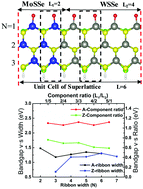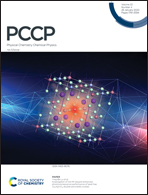Electronic and magnetic properties of the Janus MoSSe/WSSe superlattice nanoribbon: a first-principles study†
Abstract
The electronic structure properties of Janus MoSSe/WSSe superlattice nanoribbons (SLNRs) are investigated by first-principles calculations. The band structure, density of states and partial charge density are calculated. The results show that the ribbon width, combination ratio and period length have a great effect on the properties of SLNRs. Adjusting the distribution of outer S and Se atoms can restrict the spontaneous bending of the Janus nanoribbons while the properties are well preserved. The zigzag MoSSe/WSSe SLNRs (Z-SLNRs) show semiconductor and half-metal behavior depending on the ribbon width, which is quite different from the metallic properties of pristine MoSSe or WSSe nanoribbons. By modulating the ratio and period length of the two construction units, the bandgap and magnetic properties of Z-SLNRs can be tuned. The armchair MoSSe/WSSe SLNRs (A-SLNRs) are semiconductors, and the bandgap is similar to that of the corresponding armchair MoSSe or WSSe nanoribbons. As the width increases, the bandgaps of A-SLNRs show a variant behavior. It is found that A-SLNRs are all semiconductors regardless of the composition ratio, and the bandgaps also vary with the composition ratio of the constituent materials.



 Please wait while we load your content...
Please wait while we load your content...